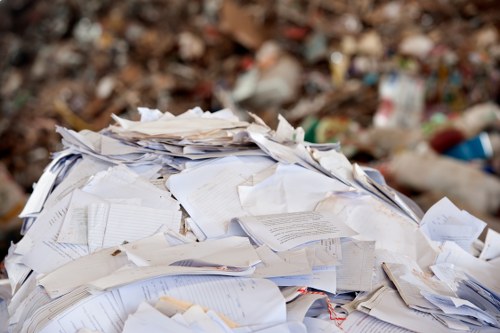Site Clearance in Sudbury: Your Comprehensive Guide

Site clearance is a critical step in any construction or development project in Sudbury. It involves the removal of unwanted materials, debris, and vegetation to prepare the land for new construction.
Proper site clearance ensures that the land is ready for building, reducing potential delays and ensuring compliance with local regulations. Whether you're planning a residential development, commercial project, or infrastructure expansion, understanding the site clearance process is essential.
In this guide, we will explore the various aspects of site clearance in Sudbury, including the methods used, regulations to adhere to, and the benefits of hiring professional services.
Why Site Clearance is Essential

Site clearance is the foundation of any successful construction project. Without proper clearance, projects can face significant hurdles, including legal issues, increased costs, and safety hazards.
Key reasons why site clearance is essential include:
- Preparation for Construction: Clearing the site ensures that the land is ready for building.
- Regulatory Compliance: Adhering to local bylaws and environmental regulations.
- Safety: Removing debris and potential hazards reduces the risk of accidents.
- Cost Efficiency: Minimizing unexpected expenses by addressing issues early.
By addressing these factors, site clearance plays a pivotal role in the smooth execution of any development project.
Moreover, thorough site clearance can enhance the overall quality and longevity of the construction, ensuring that the foundation is solid and free from obstructions.
Site Clearance Process in Sudbury

The site clearance process in Sudbury involves several steps to ensure that the land is adequately prepared for construction. Understanding these steps can help project managers and developers plan effectively.
1. Site Assessment: Before any physical work begins, a comprehensive assessment of the site is conducted to identify existing structures, vegetation, and potential hazards.
2. Permitting and Regulations: Securing the necessary permits and ensuring compliance with Sudbury's local regulations is crucial to avoid legal complications.
3. Vegetation Removal: This involves clearing trees, shrubs, and other vegetation. Sustainable practices are often employed to handle waste responsibly.
4. Debris and Material Removal
All unwanted materials, including old structures, debris, and hazardous waste, are removed from the site. Proper disposal methods are followed to minimize environmental impact.
5. Grading and Leveling: The land is then graded and leveled to create a suitable base for construction, ensuring proper drainage and stability.
6. Soil Testing: Testing the soil quality helps determine its suitability for construction and identifies any necessary soil treatments.

Each step in the site clearance process is vital for the success of the project. Skipping or inadequately performing any of these steps can lead to significant issues down the line.
Professional site clearance services in Sudbury are well-versed in navigating these steps efficiently, ensuring that the project stays on track and meets all regulatory requirements.
Additionally, these professionals use specialized equipment and techniques to perform the clearance swiftly and effectively, minimizing disruption to the surrounding environment.
Methods of Site Clearance

There are various methods used in site clearance, each suited to different types of projects and site conditions. Selecting the appropriate method is crucial for efficiency and effectiveness.
Mechanical Clearance: Utilizes heavy machinery such as bulldozers, excavators, and skid steer loaders to remove vegetation and debris quickly. This method is ideal for large-scale projects where speed is essential.
Manual Clearance: Involves using hand tools like chainsaws, machetes, and shovels to clear smaller areas or navigate difficult terrain. This method is labor-intensive but allows for greater precision and minimal environmental disruption.
Hydraulic and Chemical Methods
Hydraulic Methods: These involve using water-based techniques to manage and remove unwanted materials. It's particularly useful in areas prone to erosion or where water management is a concern.
Chemical Methods: Utilizes herbicides and other chemical agents to eliminate unwanted vegetation. This method requires careful handling to prevent environmental contamination and must comply with local regulations.
Choosing the right method depends on factors such as the size of the site, the types of materials to be removed, environmental considerations, and project timelines.

Integrating multiple methods can often yield the best results, allowing for flexibility and adaptability in various site conditions.
Professional site clearance services in Sudbury are adept at selecting and combining these methods to achieve the desired outcome efficiently and safely.
Additionally, advancements in technology have introduced more sustainable and efficient clearance methods, further enhancing the effectiveness of site preparation.
Regulations and Permits

Adhering to local regulations and obtaining the necessary permits is a critical aspect of site clearance in Sudbury. Non-compliance can result in fines, project delays, and legal complications.
Key Regulations to Consider:
- Environmental Protection: Ensuring that clearance methods do not harm the local ecosystem.
- Zoning Laws: Adhering to designated land use and development plans.
- Waste Disposal: Proper disposal of removed materials in accordance with municipal guidelines.
- Safety Standards: Implementing measures to protect workers and the surrounding community.
Obtaining permits typically involves submitting detailed plans outlining the clearance methods, environmental impact assessments, and safety protocols.
Engaging with local authorities early in the process can facilitate a smoother approval process and ensure that all requirements are met.
Environmental Considerations

Environmental stewardship is an integral part of site clearance in Sudbury. Responsible clearance practices help preserve the local environment and promote sustainability.
Key Environmental Considerations:
- Preservation of Native Flora and Fauna: Minimizing the impact on local plant and animal species.
- Erosion Control: Implementing measures to prevent soil erosion and sediment runoff.
- Waste Management: Recycling or repurposing materials wherever possible to reduce landfill waste.
- Habitat Restoration: Restoring the site post-clearance to support biodiversity.
Using eco-friendly clearance methods and materials can significantly reduce the environmental footprint of a construction project.
Additionally, conducting environmental impact assessments helps identify potential risks and develop strategies to mitigate them effectively.

Collaboration with environmental experts ensures that the site clearance process aligns with sustainability goals and regulatory standards.
Moreover, incorporating green practices not only benefits the environment but can also enhance the project's reputation and community support.
Adhering to these considerations demonstrates a commitment to responsible development and long-term environmental health.
Choosing a Site Clearance Provider in Sudbury

Selecting the right site clearance provider is crucial for the success of your project. A reputable provider will offer expertise, reliability, and comprehensive services tailored to your needs.
Factors to Consider:
- Experience and Expertise: Look for providers with a proven track record in site clearance and familiarity with Sudbury's regulations.
- Comprehensive Services: Providers should offer a range of services, including assessment, clearance, waste management, and site restoration.
- Equipment and Technology: Ensure that the provider uses modern, well-maintained equipment to perform efficient and safe clearance.
- Environmental Commitment: Choose providers who prioritize sustainable practices and environmental responsibility.
Additionally, seeking recommendations and reading reviews can provide insights into a provider's reliability and quality of work.
It's also beneficial to engage in consultations to discuss your project's specific needs and assess how the provider can meet them effectively.
Cost and Value
While cost is an important factor, it shouldn't be the sole consideration. Evaluating the value offered, including quality, efficiency, and additional services, is essential to ensure a successful partnership.
Transparent pricing and detailed estimates can help you understand the cost structure and avoid unexpected expenses.
Investing in a reputable site clearance provider can lead to long-term savings by preventing project delays and reducing the risk of costly mistakes.

Ultimately, selecting the right site clearance provider in Sudbury involves balancing cost, expertise, and commitment to quality and sustainability.
By taking the time to evaluate your options carefully, you can secure a partner that will contribute to the smooth and successful execution of your construction project.
If you're ready to begin your site clearance project, contact us today to discuss your needs and receive a comprehensive quote tailored to your project.
Benefits of Professional Site Clearance

Hiring professional site clearance services in Sudbury offers numerous advantages that contribute to the overall success of your development project.
1. Efficiency and Speed: Professionals have the necessary equipment and expertise to perform clearance swiftly, keeping your project on schedule.
2. Safety Compliance: Adhering to safety standards protects workers and the surrounding community from potential hazards.
3. Cost-Effective:
While there is an upfront cost, professional clearance can save money in the long run by preventing mistakes and ensuring efficient use of resources.
4. Environmental Responsibility: Professionals implement sustainable practices that minimize environmental impact, aligning with regulatory requirements and community expectations.
5. Comprehensive Services: From initial assessment to final grading, professionals offer a full range of services, providing a seamless experience.

Additionally, professionals can provide valuable insights and recommendations based on their experience, enhancing the quality and outcomes of your project.
Their expertise in navigating local regulations and environmental considerations ensures that your project complies with all necessary guidelines.
Moreover, professional site clearance services often include warranties or guarantees, offering peace of mind and assurance of quality work.
Common Challenges in Site Clearance

Site clearance projects can encounter various challenges that may impact timelines, costs, and overall project success. Being aware of these challenges allows for better planning and mitigation strategies.
1. Unexpected Obstacles: Unforeseen elements such as buried utilities, contaminated soil, or hidden structures can complicate the clearance process.
2. Weather Conditions: Adverse weather can delay operations and affect the efficiency of clearance activities.
3. Regulatory Hurdles
Navigating complex regulations and obtaining necessary permits can be time-consuming and may require specialized knowledge.
4. Environmental Concerns: Balancing effective clearance with environmental protection is often challenging, especially in ecologically sensitive areas.
5. Budget Constraints: Managing costs while ensuring thorough and quality clearance can be a delicate balance.

To overcome these challenges, thorough planning and collaboration with experienced site clearance providers are essential.
Implementing contingency plans and maintaining flexibility in your project schedule can help address unexpected issues effectively.
Additionally, staying informed about local regulations and engaging with environmental experts can mitigate potential risks associated with site clearance.
Case Studies: Successful Site Clearance Projects in Sudbury

Examining successful site clearance projects in Sudbury can provide valuable insights into best practices and effective strategies.
Project A: Residential Development
In this project, a large plot was cleared to make way for a new housing complex. Challenges included dense vegetation and proximity to a water body.
By employing a combination of mechanical and manual clearance methods, the team efficiently prepared the site while minimizing environmental impact.
Project B: Commercial Expansion
This project involved clearing debris from an old industrial site to develop a new commercial center. Contaminated soil was a significant concern.
The site clearance team conducted thorough soil testing and implemented remediation measures, ensuring the land was safe for construction.
Project C: Infrastructure Development
A major infrastructure project required extensive site clearance to lay new utility lines. The clearance needed to be precise to avoid disrupting existing structures.
Using advanced surveying and clearance techniques, the team successfully prepared the site within the tight project timeline.

These case studies highlight the importance of tailored approaches to site clearance, considering the unique challenges of each project.
Success in these projects was achieved through meticulous planning, expert execution, and a commitment to environmental and regulatory standards.
Lessons learned from these projects can inform future site clearance endeavors, promoting efficiency and effectiveness.
Future Trends in Site Clearance

The field of site clearance is continually evolving, with advancements in technology and shifts towards more sustainable practices shaping the future landscape.
1. Automation and Robotics: The integration of automation and robotics can enhance efficiency, precision, and safety in site clearance operations.
2. Sustainable Practices: Emphasis on eco-friendly methods and waste recycling will continue to grow, aligning with global sustainability goals.
3. Advanced Mapping and Surveying
Utilizing drones and GIS technology for detailed site mapping and surveying can improve planning and execution.
4. Enhanced Safety Protocols: Innovations in safety equipment and protocols will further protect workers and reduce accident rates.
5. Integrated Project Management: Leveraging project management software to streamline coordination and communication among stakeholders.

Staying abreast of these trends allows site clearance providers in Sudbury to offer cutting-edge services that meet the evolving needs of clients.
Adopting new technologies and sustainable practices not only improves operational efficiency but also enhances the overall quality and reputation of site clearance projects.
As the industry advances, the focus will increasingly be on balancing efficiency with environmental responsibility, ensuring that site clearance contributes positively to broader development goals.
Conclusion

Site clearance in Sudbury is a foundational element of successful construction and development projects. It involves a comprehensive process of preparing the land by removing unwanted materials, debris, and vegetation.
Understanding the importance of site clearance, adhering to local regulations, and employing the right methods are crucial for project success.
Hiring professional site clearance services offers numerous benefits, including efficiency, safety, and environmental responsibility.
Take the Next Step
Ready to kickstart your construction project with expert site clearance? Book your service now and ensure your project in Sudbury begins on a solid foundation.
Our team of experienced professionals is equipped to handle all aspects of site clearance, from initial assessment to final grading, ensuring a seamless and efficient process.
Don't let site clearance become a hurdle in your development plans. Contact us today to discuss your needs and receive a tailored solution that aligns with your project's goals.